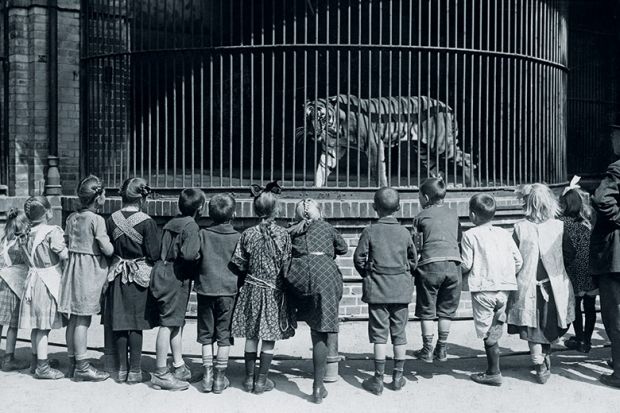"Knautschke” was one of Berlin’s most iconic animals. Born in 1943, the hippo survived the air raids at the end of the Second World War; in 1945 he was among 91 remaining animals – compared with about 4,000 in what used to be one of Europe’s foremost zoos. Thanks to handouts by Berliners, Knautschke also made it through the Berlin Airlift and, from 1950 on, his offspring provided zoos in East and West with much-needed successors. In post-war and divided Berlin such stories of endurance, support and cooperation inevitably held great weight.
Through the Lion Gate by Gary Bruce is a thoroughly engaging history of the zoo’s development through time. What makes it so fascinating is that the story of the zoo is equally telling about contemporary society and politics. Open for all right from the beginning in 1844, the oriental buildings that housed some of the animals offered a spectacular setting during the Kaiserreich – indeed, “an exotic dreamland” for the public.
The supply of animals, though, was for a long time a brutal business: the animal-tycoon Carl Hagenbeck, whose links stretched to Japan, Australia and Chile, thought nothing of killing 65 walruses to acquire just five for his customers. It would take time to turn man’s “conquest of nature” into “respect for nature” and, eventually, dedicated protection.
Animals alone were not enough for visitors hungry for spectacle and education. Before the advent of mass tourism and film, Europe’s fascination with ethnographic displays of “exotic” people provided much-needed income well into the 20th century. Bruce’s chapter on “The human zoo” follows the fate of Inuits, Nubians, Lapps and others who were exhibited in typical habitats. These shows proved enormously popular, even though, as he explains, the public disagreed at times with the racial hierarchy pursued by some academics.
By the 1930s, the number of visitors to Berlin’s zoo reached new heights and did not diminish during the Second World War. Ideologies filtered into zoo politics – the chapter on “The zoo and Hitler’s worldview” is illuminating. Nazi animal protection legislation was extensive and stands in painful contrast to their treatment of people. A programme of “breeding back” – notably of the extinct aurochs – betrayed the contemporary obsession with a glorified rural Germanic past.
The Cold War was also played out in zoos – and in the divided city, East Berlin’s second zoo (Tierpark) first opened in 1955 with hands-on support from the public. It proved an impressive achievement. “A tale of two zoos” details a communist success story – even though the popular director was a former member of the National Socialist party.
Bruce shows two things particularly well: the history of zoos is fascinating in terms of cultural and political thinking in the 19th and 20th centuries. And, despite many national and international parallels, the Berliners’ attachment to their zoo clearly stands out: “they rallied”, Bruce writes, “around their zoo animals like no other urban residents”, lending support during numerous crises. The Berlin Zoo, it seems, allowed for a degree of continuity in a city marked by change. The iconic status of the likes of Knautschke – or, in more recent years, the polar bear Knut (pictured) – is about the animals, for sure, but it also reflects the visitors’ need to project hopes and concerns.
Ulrike Zitzlsperger is associate professor of German at the University of Exeter.
Through the Lion Gate: A History of the Berlin Zoo
By Gary Bruce
Oxford University Press, 320pp, £22.99
ISBN 9780190234980
Published 24 August 2017




